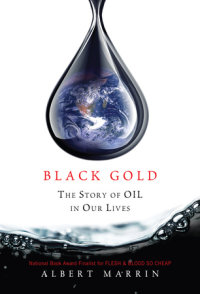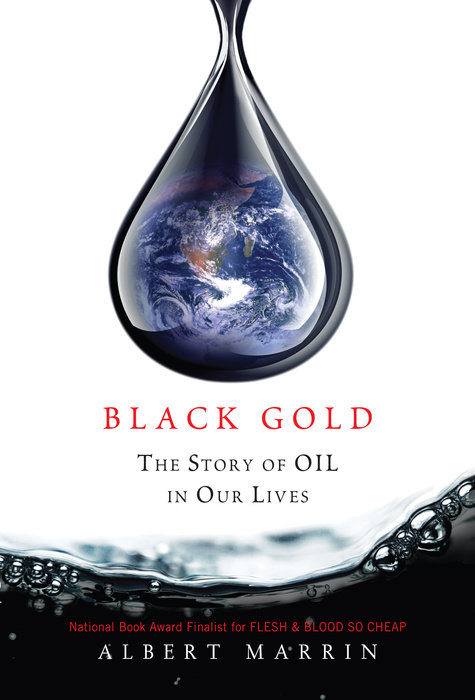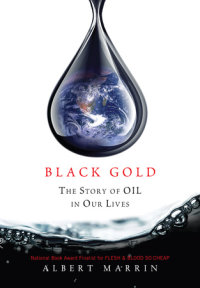1
A FREAK OF GEOLOGY
The stuff we pump into our gas tanks is a freak of geology, the product of a series of lucky breaks over millions of years. --Tim Appenzeller
Of Earth and Living Beings
Oil is not pretty. When it is taken from beneath the earth's surface, it is called crude oil, or crude for short. Although crude can be green, red, straw-colored, or chocolate brown, it is usually black. Because it is so valuable, in the late 1800s people in the industry nicknamed it "black gold." Since then, it has made fortunes for the lucky few and provided jobs for millions of ordinary folks.
Thick and slippery, crude oil has an evil smell, giving off vapors that make eyes water and throats sore. Yet without it, life as we live it today would be impossible. Oil fuels the engines that move us and our goods from place to place. It heats our homes and powers the machines that make the everyday things we take for granted. Thousands of products, from drinking straws to plastic shopping bags,…
1
A FREAK OF GEOLOGY
The stuff we pump into our gas tanks is a freak of geology, the product of a series of lucky breaks over millions of years. --Tim Appenzeller
Of Earth and Living Beings
Oil is not pretty. When it is taken from beneath the earth's surface, it is called crude oil, or crude for short. Although crude can be green, red, straw-colored, or chocolate brown, it is usually black. Because it is so valuable, in the late 1800s people in the industry nicknamed it "black gold." Since then, it has made fortunes for the lucky few and provided jobs for millions of ordinary folks.
Thick and slippery, crude oil has an evil smell, giving off vapors that make eyes water and throats sore. Yet without it, life as we live it today would be impossible. Oil fuels the engines that move us and our goods from place to place. It heats our homes and powers the machines that make the everyday things we take for granted. Thousands of products, from drinking straws to plastic shopping bags, from plant fertilizer to computers and medical equipment, begin as crude oil. So do most school backpacks, knee guards--even the yellow "rubber" duck floating in your bathtub. Modern weapons such as tanks, aircraft, and ships are so much metallic junk without oil products to make them run.
Oil influences every aspect of modern life. It has helped shape the history, society, politics, and economy of every nation on Earth. Nations have fought wars for black gold, and sadly, probably will do so in the future. Yet few who rely on this vital substance know much about it. What, exactly, is oil? How was it formed? When? Where?1
To understand oil, we must begin with a key rule of science: change alone is changeless. This may sound odd, but it is true. Nothing stays the same forever. Change governs everything in the universe, from distant galaxies, stars, and planets to tiny bacteria and giant whales--and us humans, too. Many changes in nature, such as the formation of mountains, happen too slowly for us to notice, unfolding over many lifetimes, even millions of years. When we do see rapid and sudden changes, they are usually bad for us. For example, the people of the Italian city of Pompeii had lived for generations in the shadow of Mount Vesuvius, a dormant, or "sleeping," volcano. In the year AD 79, the sleeper awoke with an outburst of flame and fury. Within hours, it sent clouds of hot ash and gas to choke over 20,000 people, nearly all of Pompeii's residents.
Mountain ranges and volcanoes are features of the geology of the planet Earth. Geology is the science that studies the structure and history of the earth as recorded in the rocks. If you could slice deep into the earth, you would find that it is arranged in layers. Geologists--earth scientists--believe that the topmost layer of rock, or crust, is between four and forty miles thick. Earth's crust is like an eggshell broken into ten enormous slabs and numerous smaller ones. These slabs, called plates, float on a layer of partially molten rock called the mantle--that is, the layer of rock between Earth's crust and core.
Every continent and ocean floor rests atop one or more plates. Driven by heat currents from Earth's core, plates are always in motion, always changing position. Although the plates move slowly, just a few inches a year, their movements have shaped Earth's crust--and still do. Moving plates push against, slide past, and grind under one another. When two plates scrunch together, they trigger earthquakes that create volcanoes and mountain ranges such as the Rockies, Andes, and Himalayas.
Yet not even a mountain range can resist the force of flowing water. Water is invincible. Given enough time, it will erode--wear away--the hardest rocks. Rushing rivers break off bits of rock. Carried downstream, these bits bounce along a river's bottom, or bed, further shattering into coarse gravel or grains of fine sand.
Inevitably, rivers lose power as they run off from a continent and enter an ocean. In doing so, they drop the materials they carried, called sediment, into the coastal waters. Tides and currents move the sediment into deeper waters, far from shore. Settling on the ocean floor, it slowly builds up in layers that may become miles thick. As the lower, older sediment layers get buried deeper, the weight of the upper, younger layers compresses and hardens them, turning them to stone. These are the layers we see along the walls of deep cuts in Earth's surface, such as the walls of the Grand Canyon of the Colorado River. The mighty Colorado carved its canyon over millions of years, as it still does today.
Life began in the oceans, thanks to the sun. Nearly ninety-three million miles from Earth, the sun, like other stars, is a glowing ball of hot gases. Most of the sun's energy, in the form of light, is lost in deep space. However, a tiny fraction reaches Earth, where it drives the weather by heating the atmosphere and oceans, fueling life.
Ancient peoples worshipped the sun. For them, sunlight symbolized life, while darkness symbolized death--eternal night. Although the ancients could not explain why, modern science has shown how sunlight sustains life on Earth. From about 3.8 to 2.5 billion years ago, the first plants and animals developed in the oceans. Over millions of years, some of these changed, or evolved, in ways that allowed them to move onto the land. Every land plant and animal alive today has ancestors that once emerged from the oceans.
Like their modern kin, the earliest life-forms were what scientists call self-feeders. These are green plants, which trap solar energy through photosynthesis--that is, the process of turning sunlight into chemical energy. Energy is the power to do work or to act. Green plants store chemical energy and use it to live, especially to turn it into food for themselves. Thus, they are self-feeders.
Animals are other-feeders, or consumers. No animal can make its own food. To live, it must feed on plants, absorbing the chemical energy stored in them. Some animals, however, get their energy in another way. Carnivores, or flesh eaters, eat the plant eaters and other flesh eaters, too.
Most living beings vanish after they die. Microscopic bacteria nearly always consume the remains of the dead, leaving no trace. We call this decay. Yet, occasionally, some naturally preserved remains survive. These remains of ancient life-forms are fossils, from the Latin word fossilis, for "dug up." Generally, only the hard parts survive as fossils. These include bones, teeth, shells, and the woody parts of plants that became petrified, or turned to stone, by absorbing minerals from the earth. Other fossils are not the actual remains of an animal or plant at all, but imprints of them left in mud that hardened before decay set in. Studying fossils can help us understand what Earth was like in the distant past and how life-forms changed over time. But most of us have no use for such fossils in our daily lives.


